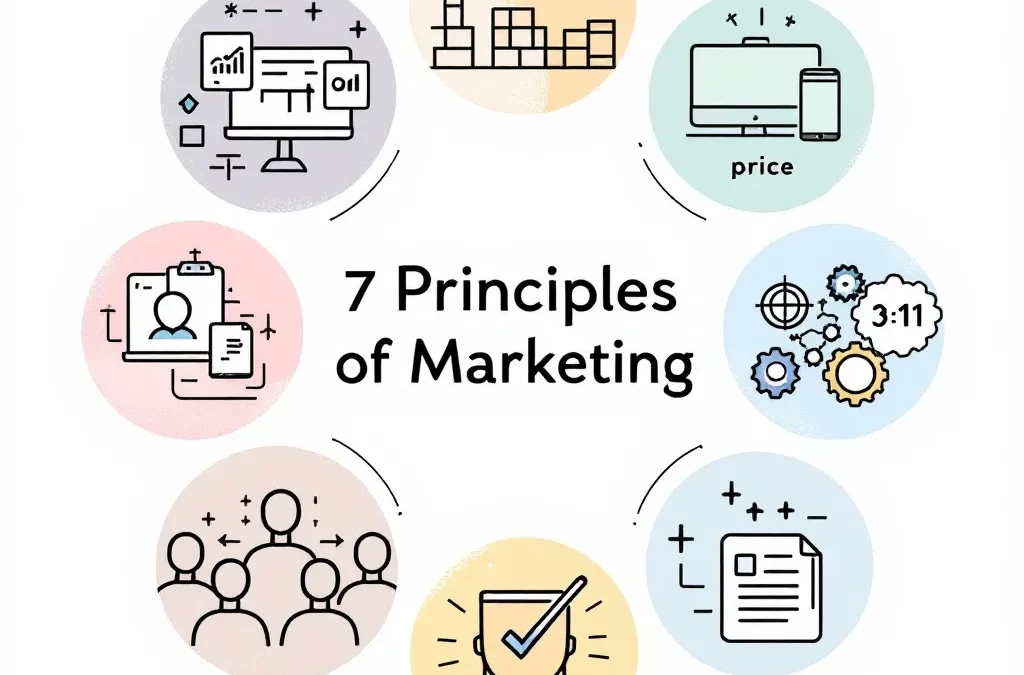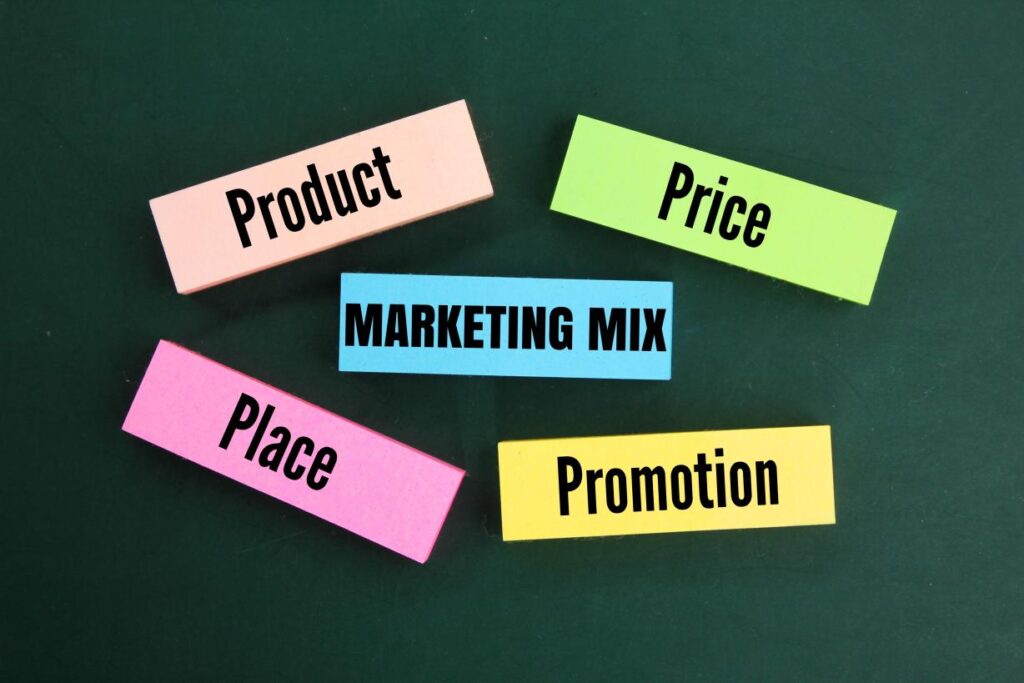If your marketing plan isn’t built on the right foundation to reach your target audience, you’ll waste time, and money, and lose customers fast. The principles of marketing are the key building blocks every business needs to get real results and stay ahead of the game.
These principles cover everything from how you shape your brand to how you reach your target market. Whether you run a product-based store or a service business, following these rules helps you grow with confidence.
Introduction to the Principles of Marketing
The principles of marketing are a set of rules that help businesses connect with people, offer value, and grow over time. They help you understand your audience and decide how to present your product or service.
They have changed over the years to fit new tools and customer habits. Businesses that follow these principles tend to build stronger brands, better content, and more loyal customers.
The 4 Ps Framework
The principles of marketing start with the 4 Ps—Product, Price, Place, and Promotion, which are basic marketing tools for meeting customer demand. These are the foundations of every marketing plan. They help businesses build offers that people actually want and are willing to buy. When done right, the 4 Ps work together to guide decisions, improve sales, and build long-term trust.
Product
Your product is the core of your business. It’s the thing people are paying for. It can be a physical good, a service, or even a digital product like an online course or downloadable file.
But a product is more than just what you sell. It’s also how you package it, how it works, what features it offers, and how it solves a problem for your audience. A good product fits the needs of a specific group of people. It gives them value that feels real to them.
You should know what makes your product different from others in the market. You should also have a clear answer for why someone would choose yours over the next option. This can come from features, price, quality, or customer service.
Constant feedback is part of marketing research and is crucial for developing satisfied customers. If people complain, ignore it and you risk losing sales. If people love something, keep it and build on it.
Product decisions also include product line strategy. Should you sell one product or many? Should you offer different versions for different types of buyers? These choices shape how people see your brand.
Price
Price affects how people view your product and your business, especially in relation to customer value. It also affects how much profit you make. Your pricing must match the value your product gives, the expectations of your audience, and the position you want to hold in the market.
There are different pricing strategies to consider:
- Cost-plus pricing adds a markup to what it costs to produce the product.
- Value-based pricing sets the price based on how much the buyer believes it’s worth.
- Penetration pricing sets a low price for entering the market and gaining attention quickly.
- Skimming sets a high price at launch, then lowers it over time.
Discounts, payment plans, and bundling also fall underpricing. Even small price changes can impact buying behavior. It is too cheap, and people may doubt the quality. Too expensive, and they might walk away.
Price also includes hidden costs. This could be shipping, service fees, or time spent waiting. These should be considered when deciding how your pricing will look to the buyer.
Want to master the principles of marketing for lasting success?
Contact Growth Hackers
Place
Place is where people buy your product or service. It’s about your distribution channels. You need to be present where your customers are already looking.
This could mean a physical store, a website, an e-commerce platform, or a third-party retailer. In digital marketing, a place often means your website, app, social channels, or wherever you’re making transactions happen.
Place also covers logistics—how products are delivered, how quickly they arrive, how well your system handles orders, and how returns work. If this part fails, even the best product won’t be enough.
You can also consider expanding your reach through multiple channels. This might include having a direct-to-consumer website plus listings on Amazon or other marketplaces. More touchpoints often mean more chances to sell—but they must be managed properly.
Even service-based businesses need to think about place. If your business operates online, the customer experience on your platform matters just as much as your product.
Promotion
Promotion is how people learn about your product. It includes all the ways you reach your audience and convince them to take action.
This can involve digital ads, email campaigns, SEO, social media, content marketing, and word of mouth. Traditional options like flyers, radio, and TV can still work, depending on your audience.
Each promotion channel has a purpose. SEO helps people find you on Google. Social media builds community. Paid ads drive fast traffic. Email builds relationships over time. Together, these form a mix that gets your message out in more than one way.
Promotion is also about timing. A well-timed sale, post, or ad can bring in more buyers than a poorly timed one. Understanding your audience’s behavior helps you promote at the right moments.
Your message needs to match your brand. It must speak directly to the audience’s problems and goals. Clear, honest, and simple messages tend to work best.
How the 4 Ps Work Together
All four of these elements are connected. A change in one affects the others. If your product changes, your price might need to change. If your place shifts to online-only, your promotion must follow.
The most successful strategies keep all four parts aligned. You don’t want a high-end product with a cheap look. You don’t want a premium price on a poor experience.
Review these parts often. Market research helps you stay updated on what your competitors are doing and what your audience expects. Customer needs change, competition shifts, and new tools come up. You must adjust to stay relevant.
The 7 Ps of Marketing: Adding People, Process, and Physical Evidence
The 4 Ps work well for physical products. However, service and online businesses face extra challenges. That’s where the other 3 Ps—People, Process, and Physical Evidence—come in. These give a fuller picture of what it takes to deliver a good customer experience.
People
People are everyone who plays a role in your business. This includes staff, sales reps, customer service agents, and even freelancers. Every person who interacts with a customer shapes the experience they remember.
You want your team to reflect your brand. If your brand is friendly, your support team should be approachable. If your product promises speed, your staff should act fast and be responsive.
Training matters here. The best products can be ruined by poor service. Your team needs the right knowledge, attitude, and tools to do their jobs well.
In some cases, people also include your customers. Customer communities, reviews, and user content all help build trust and spread awareness.
Hiring and team culture fall under this P. If your team believes in your mission, they will show that belief in how they treat your customers.
Process
Process is how you deliver your product or service. It covers every step the customer goes through, from finding your business to paying and receiving what they bought.
A smooth process makes people come back. A clunky one drives them away.
Look at every part of the journey: browsing your website, filling out forms, speaking to a rep, waiting for delivery, or getting follow-up support. Remove anything that causes confusion, delays, or frustration.
Automating steps, offering fast response times, and simplifying sign-ups can make a big difference. Businesses often lose leads not because the offer is bad, but because the process gets in the way.
Process also includes behind-the-scenes tasks. Order management, stock handling, appointment scheduling, and customer tracking must all run smoothly.
Every touchpoint should feel consistent. People should never feel lost, ignored, or annoyed during the process.
Physical Evidence
Physical evidence is the visible proof that your brand and service are real. It helps build trust with people who can’t see or touch your product before buying.
This includes your website layout, reviews, business cards, packaging, uniforms, or office space. Every detail people can see should match what your brand says about itself.
Online, this includes your user interface, mobile experience, FAQ section, and even your email formatting. A polished look tells buyers you care. A sloppy one raises doubts.
Reviews, testimonials, and ratings matter a lot. They offer proof that others trust you. Photos of your work, behind-the-scenes posts, and user stories also give people something solid to judge.
Even if your business is 100% digital, people still look for real-world signs of reliability. Show them you’re serious by keeping every visual part of your business clean, clear, and consistent.
Modern Need for 7 Ps
Traditional marketing focused mostly on products sold in physical stores. That’s where the 4 Ps came in handy. But business today looks very different.
Many companies now sell services, subscriptions, or digital goods. They also deal with online buyers who expect fast answers, smooth experiences, and proof they can trust you. That’s why the original 4 Ps are no longer enough on their own to achieve sustainable marketing.
The 7 Ps model adds three key parts that speak directly to how people shop and interact today. These include how your staff treats customers, how smoothly your systems run, and what signs show you’re real and trustworthy. Without these, online and service-based businesses often struggle to grow.
If you run a tech startup, online store, coaching service, or digital subscription, the extra 3 Ps are a must. They help fix gaps that can’t be covered by price or promotion alone. A glitchy checkout, a rude message, or no reviews can lose a customer fast.
Common Mistakes Businesses Make with the 7 Ps
Product: Selling Without Solving a Real Problem
Some businesses focus too much on what they want to make instead of what their audience actually needs. They launch products that look good on paper but don’t solve any real issues. People don’t buy something unless they see how it helps them or makes life easier.
Others copy what’s trending without understanding why that product is doing well. This creates a poor copy that lacks purpose. If it doesn’t have a clear use or benefit, people lose interest fast.
Too often, businesses add too many features thinking more means better. However, too much can confuse or overwhelm users. A simple, clear product with one strong benefit usually does better than a cluttered one.
Price: Getting the Numbers Wrong
One common mistake is pricing based on cost alone. Just because something costs $10 to make doesn’t mean it should be priced at $15. Customers look at value, not just cost. If they don’t feel it’s worth the price, they won’t buy.
Some brands try to look premium by setting high prices without building trust first. Without proof of value, a high price feels like a rip-off. On the flip side, going too cheap makes people think it’s low quality.
Discounting too often also causes problems. If people always wait for a sale, they’ll stop paying full price. Over time, this kills profit and makes it hard to raise prices later.
Before finalizing pricing, companies should conduct marketing research to understand what customers are willing to pay and why.
Apply the principles of marketing and get real results!
Place: Showing Up in the Wrong Spots
A strong product won’t sell if people can’t find it. Many businesses set up shop in places that don’t match where their customers hang out. Selling on Instagram works for some brands, but not all. A B2B product sold through TikTok probably won’t work well.
Some skip basic steps like making sure their website is fast and mobile-friendly. If someone clicks a link and the site doesn’t load, they’re gone. If the checkout is slow or clunky, they’ll leave without buying.
Others ignore the power of local channels. A small store that only focuses online might miss strong foot traffic in their own area. It’s about meeting people where they already spend time.
This part of the marketing mix often gets overlooked—how and where your product reaches the customer is just as important as what you sell.
Promotion: Talking Without Saying Anything
Businesses often spend money on ads but say the wrong thing. They focus on features instead of benefits. People care less about specs and more about how it helps them feel, look, or save time.
Some use confusing language or vague slogans. If a message isn’t clear in seconds, people scroll past. Others overpromise and underdeliver, which kills trust.
There’s also a tendency to post just for the sake of posting. Sending out random content with no plan won’t build interest. A promotion should connect to a clear goal—whether it’s getting clicks, signups, or sales.
People: Forgetting the Human Part of Business
Even with good products and ads, bad service can ruin everything. If staff are rude, slow, or don’t know the product, it leaves a bad impression. People remember how they were treated more than what they bought.
Some businesses skip proper training. If customer support can’t answer questions or fix problems quickly, people won’t come back. Team members need the tools and knowledge to do their job well.
Businesses that treat staff poorly also feel the impact. Unhappy workers don’t give great service. If turnover is high, customers notice the chaos. Happy, well-trained staff help the whole brand feel more trustworthy.
Well-trained staff also play a big part in how you connect with prospective customers and keep them interested.
Process: Making Things Harder Than They Should Be
A clumsy process kills sales. If buying takes too many clicks or steps, people give up. Long forms, missing info, or unclear next steps confuse and frustrate users.
Some companies overcomplicate the experience to seem more professional. But complexity doesn’t build trust—clarity does. Buyers want quick answers, fast checkouts, and simple paths.
Businesses also fail by not testing the process themselves. If no one checks how the system works for the user, problems go unnoticed. It’s important to walk through it regularly to catch what’s slowing people down. In international marketing, this becomes even more important—what works in one region may confuse or frustrate customers in another.
Physical Evidence: Skipping the Proof People Need
Many service-based or online businesses forget that customers need to see proof before they buy. This might be reviews, testimonials, product photos, videos, or even how the site looks. If things seem sketchy or unpolished, people leave.
Some websites don’t show who’s behind the business. No team photos, no “About” page, and no clear contact details. That makes it hard to trust. Even simple signs like a clean logo, real photos, or store hours help people feel secure.
Others hide their feedback—especially the bad kind. But showing honest reviews, even mixed ones, can actually help build trust. It shows you’re real and willing to listen.
Final Thoughts on the 7 Principles of Marketing You Need to Follow to Create a Successful Strategy
In today’s competitive landscape, understanding and applying the principles of marketing is crucial for business success. These principles—Product, Price, Place, Promotion, People, Process, and Physical Evidence—serve as the foundation for building a strong marketing strategy that resonates with customers and drives growth. By mastering each aspect of these principles, businesses can gain a deeper understanding of how to adapt to market changes and create lasting customer relationships.
The 7 Ps framework, when implemented effectively, can help businesses tackle challenges and achieve scalable results. Whether you’re running a service-based or product-driven business, focusing on these principles allows you to optimize your marketing process, improve customer experiences, and ultimately boost sales and brand loyalty.
Growth Hackers is a performance-oriented digital marketing agency and we specialize in implementing the principles of marketing to deliver visible, impactful results for your business. Our team works closely with you to create tailored strategies that bring fast, sustainable, and scalable growth, helping you outshine your competition.
If you’re ready to make the most out of your business by applying the marketing principles that align with your goals, reach out to Growth Hackers today. Let’s work together to build a brand that stands out and drives success!







